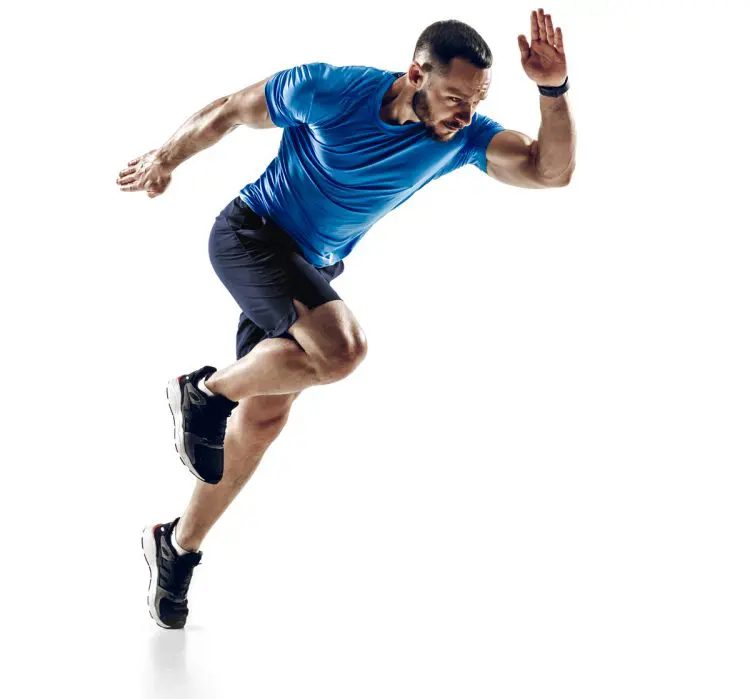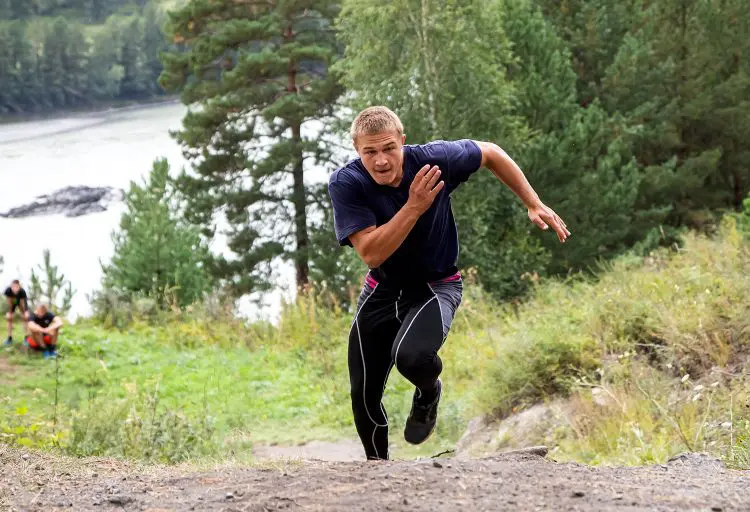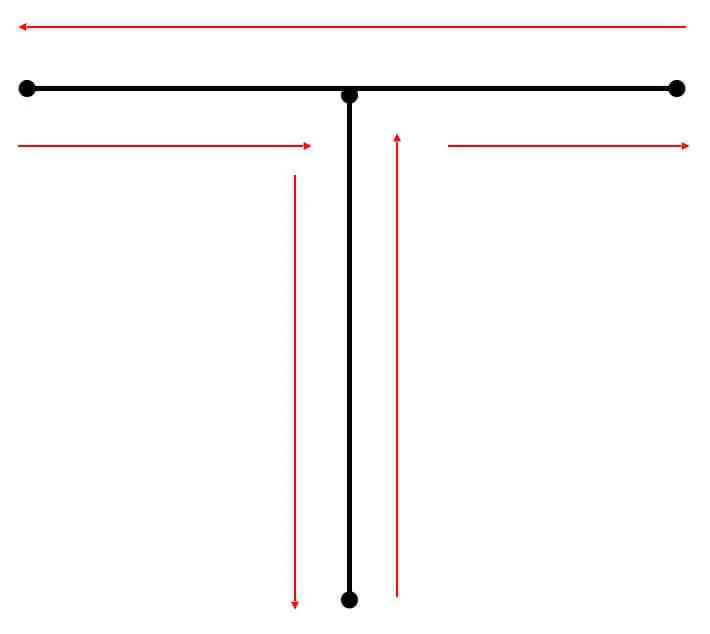Speed is one of the most critical attributes in sport. When you are fast, you’re harder to block or tackle, better able to get into space to receive a pass, and can chase down the opposition more effectively. It doesn’t matter if you play basketball, soccer, or football; speed will make you a better player.
Some athletes are naturally faster than others. An abundance of type 2b fast-twitch muscle fibers means that some people are built for speed rather than endurance. Those same type 2b fibers also have the greatest potential for muscle growth.
That said, while your speed potential is limited by your genetics, you can still improve your pace with the right kind of training.
This workout plan is designed to make you faster on your feet while improving your general fitness, strength, power, and endurance. It’s ideal for off-season athletes and anyone looking to add some variety to their training.
Speed Training Plan – Overview
There is more to speed than just running fast. Successful sprinting is a combination of several convergent factors, including power, mobility, foot speed, and agility. This program mixes sprinting with gym-based training to address all of the fitness components that contribute to your running speed.
This is your workout plan for the next four weeks:
Level Up Your Fitness: Join our 💪 strong community in Fitness Volt Newsletter. Get daily inspiration, expert-backed workouts, nutrition tips, the latest in strength sports, and the support you need to reach your goals. Subscribe for free!
| Mon | Tue | Wed | Thu | Fri | Sat | Sun |
| Sprint workout 1 | Strength and power 1 | Sprint workout 2 | Rest and recovery | Strength and power 2 | Sprint workout 3 | Rest and recovery |
Because this is such an all-inclusive training plan, as well as getting faster, you will probably get stronger, leaner, and fitter too. As such, even if you don’t play sports, non-athletes will enjoy the benefits of this workout plan.
Try our Running Pace Calculator
Warming Up
A good workout starts with a proper warm-up. Warming up prepares your body and mind for what you are about to do. As well as reducing your risk of injury, warming up should also make your workouts more productive by maximizing exercise performance.
To warm-up for strength training, start your workout with 5-10 minutes of easy cardio, followed by dynamic flexibility and mobility exercises for all your major muscles and joints. Finish off by doing a few progressively heavier sets of the main exercises in your workout.
For example, if you are working up to 225 lbs. for squats:
- 10 reps – 45 lbs. (empty bar)
- 8 reps – 85 lbs.
- 5 reps – 135 lbs.
- 2 reps – 175 lbs.
- 225 lbs. – 1stwork set
However, a sprint warm-up is a little different. Warming up for sprinting involves the same pulse raiser, mobility, and flexibility components but must also include some additional preparatory exercises to make sure you are ready to run.
After your general warm-up of 5-10 minutes of easy cardio, mobility, and flexibility, do the following preparatory exercises.
1 – Sprint drills
2-3 sets of 20 yards of:
- High knee running – focus on knee height rather than forward speed
- Butt kickers – bring your feet up to your butt as you jog forward
- High knee skips – focus on driving hard from your takeoff leg
- Carioca sideways running – left side lead
- Carioca sideways running – right side lead
2 – Strides
Strides are practice sprints where you get to hone your technique and prepare your muscles for your coming workout. Simply sprint at 50-70% of your maximum speed from a rolling start. Increase your speed gradually across several sets until you feel you are ready to start your workout.
Five sets over 30-50 meters should suffice. Focus on things like upper body relaxation, arm drive, and staying up on your toes.
3 – Starts
Going from stationary to top speed in the shortest possible time puts a lot of strain on your body. This is potentially the most dangerous part of any sprint workout. Prepare your body by doing 3-5 standing starts. Sprint just 15-20 yards, walk back and repeat. Increase the speed and aggressiveness of your starts over several attempts.
The Workouts
In track sprinting, you know exactly how far you’re going to run and can train accordingly. For example, 100-meter sprinters rarely run more than 100 meters as doing so would not be specific to their chosen event.
Soccer, football, and rugby players must be fast over a range of distances, from a few yards to the length of the field. Also, they need to sprint many times during the course of a game, often covering several miles in total. Because of this, they don’t just need speed; they need speed, endurance, and fitness too.
The following workouts are designed to improve all of the components you need to get faster for sports.
Sprint Workout #1 – Mixed Distances

This workout will increase your speed over a range of distances while improving your endurance and fitness. Your speed will naturally decrease as the sprints get longer. Just try and cover each distance as quickly as you can.
Use a rolling start for the first two parts of this workout and standing starts for the last two. A rolling start involves jogging up to your start line, so you are already moving at the beginning of each interval. A standing start is a stationary start.
- 10 x 15-yard sprints (walk back slowly and recover as needed)
- 8 x 25-yard sprints (walk back slowly and recover as needed)
- 6 x 40-yard sprints (walk back and recover as needed)
- 4 x 70-yard sprints (walk back and recover as needed)
Strength and Power #1
It’s no coincidence that some of the fastest athletes in the world are also very muscular. After all, the more force you can generate, the faster you’ll be able to drive yourself forward. While your legs are your primary source of power during sprinting, your upper body is involved too. For this reason, to increase your speed, this plan uses full-body workouts.
To build strength and power, we are going to use a special type of superset that combines heavy weight training exercises with explosive power exercises. The heavy weights increase strength and nervous system activation, while the second exercises build power output and speed.
Level Up Your Fitness: Join our 💪 strong community in Fitness Volt Newsletter. Get daily inspiration, expert-backed workouts, nutrition tips, the latest in strength sports, and the support you need to reach your goals. Subscribe for free!
Do exercise 1a, rest two minutes, and then do exercise 1b. Rest another two minutes and go back to exercise 1a. Repeat each pairing for the prescribed number of sets. Stop each exercise 1-2 reps before failure or, in the case of the power exercises, when you notice your movement speed is starting to decrease.
| Exercise | Sets | Reps | Recovery | |
| 1a | Front squat | 4 | 4 | 2 minutes |
| 1b | Box jump | 8 | ||
| 2a | Deadlift | 4 | 3 | 2 minutes |
| 2b | Power clean | 6 | ||
| 3a | Bench press | 3 | 4 | 2 minutes |
| 3b | Plyo push-up | 8 | ||
| 4a | Chin-up | 3 | 4 | 2 minutes |
| 4b | Medicine ball slam | 8 |
Sprint Workout #2 – Speed and agility
Straight-line speed is undeniably important, but, in most sports, the ability to change direction at speed is also crucial. After all, if you can’t change speed, you will probably find yourself running straight into the opposition.
This three-part workout is designed to improve your agility as well as your speed. It involves stops, starts, turns, and swerves to mimic getting around your opponents.
1 – Zigzag sprints
Place ten cones or markers in a line, about two yards apart. Starting ten yards away from the first cone, sprint up to and then around each one as fast as you can. After the final marker, accelerate out for a final ten-yard sprint.
Walk back and then repeat to complete three reps. After your third rep, rest 2-3 minutes and then repeat.
Do three sets of three reps in total.
2 – T-Sprints
Mark out a T-shape using cones. The horizontal and vertical lines should be 10 yards long. Starting from the base of the T, run forward as fast as you can. Stop at the top and then sidestep to the right-hand marker. Stop, and then sidestep out to the left-hand marker. Stop and sidestep back to the middle marker. Finally, from the middle, run backward to the start point. Rest two minutes and then repeat. Do five sets.
3 – Broken hundreds
Your final exercise is all about agility and speed endurance. Not only are you going to run 100 yards as fast you can, but you’re also going to have to deal with lots of energy and speed-sapping starts and stops.
Set out five markers like this, with one every five yards:
1—–2—–3—–4—–5
Starting and returning to marker #1 every time, run out to each marker in turn as fast as you can. After running out to #5 and back, rest 60 seconds and repeat. Do five reps in total.
Strength and Power #2
This workout is very similar to workout #1, but we’ve changed a few of the exercises to provide some variety. As before, do the strength exercise (designated a), rest, and then do the power exercise (designated b).
| Exercise | Sets | Reps | Recovery | |
| 1a | Back squat | 4 | 4 | 2 minutes |
| 1b | Squat jump | 8 | ||
| 2a | Deadlift | 4 | 3 | 2 minutes |
| 2b | Sumo deadlift high-pull | 6 | ||
| 3a | Barbell shoulder press | 3 | 4 | 2 minutes |
| 3b | Push-ups | 8 | ||
| 4a | Pull-up | 3 | 4 | 2 minutes |
| 4b | Medicine ball slam | 8 |
Sprint Workout #3 – Hill Sprints

Your final speed workout is hill sprints. Hill sprints develop leg power as well as anaerobic fitness. Running uphill overloads your sprinting muscles so that, when you run on the flat, you’ll be able to generate more force. This workout will also improve your general fitness and burn lots of calories too.
Jog between half to one mile to warm up and reach your chosen hill. Ideally, it should be around 150-200 yards long and moderately steep. This means it’s steep enough to challenge you but not so steep you have to change your running style too much to run up it. About 5-10% is ideal.
Once you are warm, do the following. Ideally, you should measure each interval but, if that is not possible, count strides instead and do one stride for every prescribed yard. This won’t be exactly right, but it’s close enough.
- 6 x 30 yards, walk down recovery
- 6 x 50 yards, walk down recovery
- 6 x 75 yards, walk down recovery
- 6 x 100 yards, walk down recovery
Rest 2-3 minutes between each part of the workout, and finish up by jogging another half to one mile to cool down.
After Four Weeks…
Stick with this program for four weeks. That’s long enough for it to be beneficial, but not so long you start to get bored, or it stops working. After your fourth week, deload for a week, and then repeat the program or switch to something new, like our Strength Sports Workout, for example.
Speed Training Plan – Wrapping Up
Whether you play sports, want to get leaner, or just want to do something other than regular style bodybuilding training, this speed training plan could be just what you are looking for.
It combines several different sprinting and gym workouts to increase your speed over a range of distances, from five yards to 100 yards or more. Along the way, you’ll get fitter, stronger, more agile, and, of course, faster. You might even build some muscle!
On the downside, sprinting IS a high-impact activity that can take its toll on your joints. This is not a program for anyone with existing knee pain or hip pain. You’ll also need to find some outdoor space to sprint. A park would be ideal.
But, if you are reasonably fit and healthy and are looking for a new training challenge, you’ll undoubtedly enjoy these speed training workouts.










